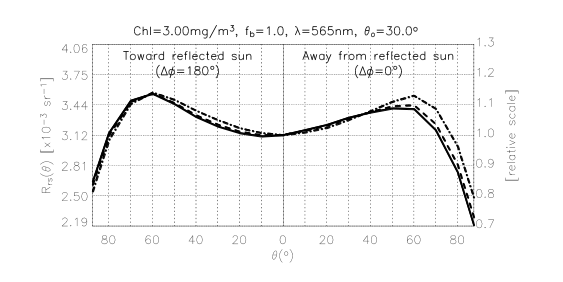Bidirectional water reflectance model
A water reflectance model, which relates water reflectance to the absorption and backscatter coefficients, is widely used for ocean colour data processing, especially for retrieval of chlorophyll, colored dissolved organic matter, suspended particulate material and inherent optical properties.
While conventional models (linear or quadratic function of bb/a or bb/(a+bb) with one or two constant coefficients) work well for low scattering waters, their validity in high scattering waters has not been proved. Moreover, such models ignore directional variation of water reflectance. Recently, a water reflectance model, which takes varying f/Q factors was proposed by Morel and colleagues (Morel and Gentili, 1996; Morel et al., 2002) and is being used for satellite data processing ( MODIS/SeaWiFS reprocessing). However, this model was designed for case 1 waters and thus should be inappropriate for turbid waters.
We published a remote-sensing reflectance model that accounts for the bidirectional variation of case 1 and case 2 waters:
Park Y. & Ruddick K. (2005). Model of remote-sensing reflectance including bidirectional effects for case 1 and case 2 waters. Applied Optics, Vol. 44(7), pp. 1236–1249. Download
The model expresses the remote-sensing reflectance as a fourth order polynomial in bb/(a+bb) (Eq. (6) in the paper). The coefficients gi(θ0, θ, ΔΦ, γb) of the model equation are tabulated for the grid values of three sun-sensor angles and the γb parameter. The γb parameter, defined by the ratio of particle backscatter coefficient (bbp) to total backscatter coefficient (bb), represents varying scattering phase function. Since this γb parameter is one of the inputs of the model coefficients, it must be estimated before applying the model. The bb measurement, if available, can be directly converted to γbvalue. Otherwise it should be (iteratively) estimated from the reflectance spectra.

ASCII files containing the coefficients and idl source for reading the files can be downloaded. A simple description of the coefficient files is also provided. Details of the radiative simulation, model uncertainty and an application example can be found in the paper.

